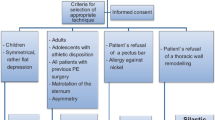Abstract
Objective
Pectus Excavatum’s (PE) surgical treatment should be patient specific. In this article, we aimed to compare parallel and cross bar variations of the Nuss method and analyze if there is any difference in results.
Methods
In this study, a total of 891 patients treated with the Nuss method between August 2005 and February 2018 were considered. These were retrieved from a prospectively recorded PE database. Of these, 276 double-bar patients were included in the study. Patients with parallel bars (225 cases) and patients with crossed bars (51 cases) were compared in terms of age, gender, symmetry, family history, additional anomalies, mean operation time, postoperative hospital stay (days) and hospital readmission rate.
Results
The mean age was measured at 20.7 for parallel bar patients and 20.1 for crossed bars patients. There was no statistically significant difference in terms of age, gender, and mean operation time between two groups. On the other hand, statistical significance was found between two groups when analyzing the deformities’ symmetry, patients’ family history and additional anomalies. The statistically significant difference of postoperative hospital stay between two groups is clinically negligible. Postoperative hospital readmission rates due to serous pleural effusion were found to be significantly increased in patients with crossed bars (p < 0.001).
Conclusion
While pleural effusion requiring readmission was statistically more frequent in cross bars, in centers where thoracentesis can be managed, Nuss method can still be applied safely, even in cases with difficult, complex deformities.
Level of evidence
III. Treatment study.






Similar content being viewed by others
References
Yüksel M, Balcı AE (ed) (2015) Göğüs Cerrahisi “Kırmızı Kitap”, 2nd edn, chapter: 59/B. In: Yüksel M, Öncel M, Sunam GS Minimal İnvazif Cerrahi, pp 633–639
Kelly RE, Shamberger RC, Mellins R, et al. Prospective multicenter study of surgical correction of pectus excavatum: design, perioperative complications, pain, and baseline pulmonary function facilitated by internet-based data collection. J Am Coll Surg. 2007;205(2):205–16.
Fonkalsrud EW, Dunn JC, Atkinson JB. Repair of pectus excavatum deformities: 30 years of experience with 375 patients. Ann Surg. 2000;231(3):443–8.
Kuru P, Bostanci K, Ermerak NE, Bahadir AT, Afacan C. Yüksel M (2015) Quality of life improves after minimally invasive repair of pectus excavatum. Asian Cardiovasc Thorac Annals. 2015;23(3):302–7.
Kelly RE Jr. Pectus excavatum: historical background, clinical picture, preoperative evaluation and criteria for operation. Semin Pediatr Surg. 2008;17:181–93. https://doi.org/10.1053/j.sempedsurg.2008.03.002.
Pilegaard HK. Short Nuss bar procedure. Ann Cardiothorac Surg. 2016;5(5):513–8.
Nuss D, Kelly RE Jr, Croitoru DP, Katz ME. A 10-year review of a minimally invasive technique for the correction of pectus excavatum. J Pediatr Surg. 1998;33:545–52. https://doi.org/10.1016/S0022-3468(98)90314-1.
Yüksel M, Lacin T, Ermerak NO, Sirzai EY, Sayan B. Minimally invasive repair of pectus carinatum. Ann Thorac Surg. 2018;105(3):915–23. https://doi.org/10.1016/j.athoracsur.2017.10.003.
Pilegaard HK. Nuss technique in pectus excavatum: a mono-institutional experience. J Thorac Dis. 2015;7(S2):S172–6. https://doi.org/10.3978/j.issn.2072-1439.2015.04.07.
Park HJ. A technique for complex pectus excavatum repair: the cross-bar technique for grand canyon type deformity (Park classification). Ann Cardiothorac Surg. 2016;5(5):526–7. https://doi.org/10.2103/acs.2016.08.01.
Kelly RE, Mellins RB, Shamberger RC, et al. Multicenter study of pectus excavatum final report: complications, static exercise pulmonary function, and anatomic outcomes. J Am Coll Surg. 2013;217(6):1080–9.
Hebra A, Kelly RE, Ferro MM, Yüksel M, Campos JRM, Nuss D. Life-threatening complications and mortality of minimally invasive pectus surgery. J Pediatr Surg. 2018;53(4):728–32. https://doi.org/10.1016/j.jpedsurg.2017.07.020.
Hebra A, Swoveland B, Egbert M, et al. Outcome analysis of minimally invasive repair of pectus excavatum: review of 251 cases. J Pediatr Surg. 2000;35:252–8.
Shu Q, et al. Experience in minimally invasive Nuss operation for 406 children with pectus excavatum. World J Pediatr. 2011;7(3):257–61. https://doi.org/10.1007/s12519-011-0319-z.
Castellani C, Schalamon J, Saxena AK, Höellwarth ME. Early complications of the Nuss procedure for pectus excavatum: a prospective study. Pediatr Surg Int. 2008;24(6):659–66. https://doi.org/10.1007/s00383-008-2106-z.
Rushing GD, Goretsky MJ, Gustin T, Morales M, Kelly RE, Nuss D. When it is not an infection: metal allergy after the Nuss procedure for repair of pectus excavatum. J Pediatr Surg. 2007;42(1):93–7. https://doi.org/10.1016/j.jpedsurg.2006.09.056.
Cheng YL, Lin CT, Bin Wang H, Chang H. Pleural effusion complicating after Nuss procedure for pectus excavatum. Ann Thorac Cardiovasc Surg. 2014;20(1):6–11. https://doi.org/10.5761/atcs.oa.12.02067.
Nuss D, Obermayer RJ, Kelly RE. Nuss bar procedure: past, present and future. Ann Cardiothorac Surg 2016;5(5):422–33. http://www.annalscts.com/article/view/11843/12227
Funding
None.
Author information
Authors and Affiliations
Corresponding author
Ethics declarations
Conflict of interest
There is no conflict of interest. Authors have no disclosures.
Additional information
Publisher's Note
Springer Nature remains neutral with regard to jurisdictional claims in published maps and institutional affiliations.
Rights and permissions
About this article
Cite this article
Sayan, B., Bekiroglu, N. & Yuksel, M. Pectus cross bars increase hospital readmission rates due to serous pleural effusion. Gen Thorac Cardiovasc Surg 70, 352–358 (2022). https://doi.org/10.1007/s11748-021-01732-z
Received:
Accepted:
Published:
Issue Date:
DOI: https://doi.org/10.1007/s11748-021-01732-z




